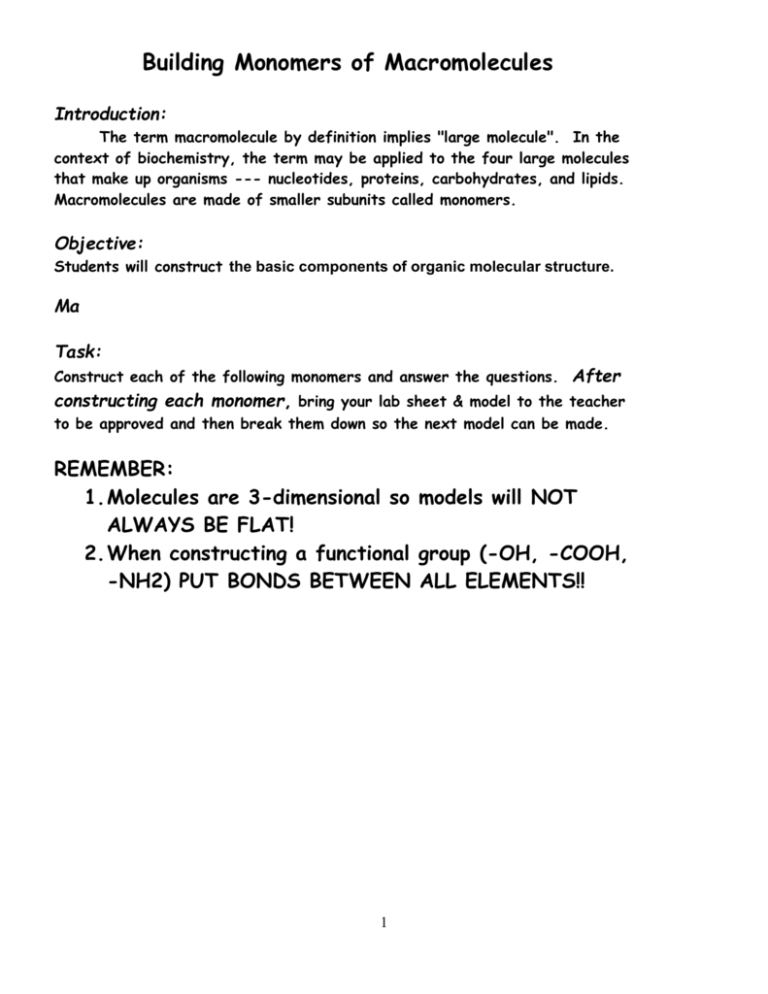Macromolecule Monomer Lab: Glucose, Glycine, Lipids, Cytosine
advertisement

Building Monomers of Macromolecules Introduction: The term macromolecule by definition implies "large molecule". In the context of biochemistry, the term may be applied to the four large molecules that make up organisms --- nucleotides, proteins, carbohydrates, and lipids. Macromolecules are made of smaller subunits called monomers. Objective: Students will construct the basic components of organic molecular structure. Ma Task: Construct each of the following monomers and answer the questions. After constructing each monomer, bring your lab sheet & model to the teacher to be approved and then break them down so the next model can be made. REMEMBER: 1. Molecules are 3-dimensional so models will NOT ALWAYS BE FLAT! 2. When constructing a functional group (-OH, -COOH, -NH2) PUT BONDS BETWEEN ALL ELEMENTS!! 1 Construct glucose. 1. What is the chemical formula for glucose? 2. Glucose is a monomer for what macromolecule? 3. What would the structural formula for a dissacharide look like using glucose as a monomer? 4. Simple sugars like glucose are called _M __ ___ ___ ___ ___ ___ ___ ___ ___ ___ ___ ___ ___ _S_. 5. What is the function of carbohydrates for the body? 2 Construct Glycine. Place a BOX around the amine group on this picture. Circle the carboxyl group on this picture. 6. Glycine is what type of monomer? (Two words) 7. Name the 4 things attached to the center carbon in ALL amino acids. A. B. C. D. 8. How many amino acids exist? 9. What element is found in amino acid that isn’t found in simple sugars like glucose or fructose? 10. Amino acids join together to make what type of macromolecule? 11. What are some of the functions of proteins in the body? (List several) 3 Construct Glycerol. Place a CIRCLE around a hydroxyl group. 12. Besides glycerol, what other molecules make up a triglyceride, which is part of a lipid? 13. Triglycerides (glycerol +fatty acid chains) are the monomers for what type of macromolecule? 14. Give 3 types of lipids and give their function. A. B. C. 4 Construct a Fatty acid. Place a BOX around the hydrocarbon chain in these pictures. Circle the carboxyl group in both pictures. 17. Fatty acids are made of long chains of _______________ atoms with attached ______________ atoms. 18. How many bond(s) does each carbon atom have? 19. How many bond(s) does each hydrogen have? 20. What 3 elements make up fatty acids? A. B. C. 5 Construct Cytosine. 21. Cytosine is an example of a nitrogen base found on _______________ acids. 22. Name the 2 nucleic acids found in organisms. 23. List the name for the elements making up cytosine. 24. Other than a nitrogen base, what other groups make up a nucleotide (there are two of them)? 6











